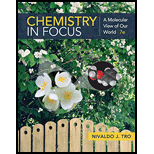
Interpretation:
The given statement is to be explained.
Concept Introduction:
Water gets polluted due to the presence of various biological and chemical contaminants in it. Biological contaminants include microorganisms such as Giardia, Legionella while chemical contaminants are mercury, lead, benzene, trichloroethylene etc. Both these render water unfit for consumption by human beings and animals, if the contaminant exceeds a certain limit, termed as the Maximum Contaminant Limit.
The concentration of a contaminant is reported as the mass of contaminant (in milligrams) present in one liter of water.
Hard water is a solution of calcium and magnesium salts in water. Presence of calcium and magnesium ions makes water hard and renders it unusable for various purposes, such as cleaning clothes and utensils, and in water heaters etc.
Boiling of water cannot get rid of contaminants because this process decreases the total volume of the sample but the mass of the contaminant remains same. Moreover, the concentration of the contaminant increases.
Want to see the full answer?
Check out a sample textbook solution
Chapter 12 Solutions
Chemistry In Focus
- Write the Lewis structures and give the electron-region geometry, molecular geometry, and bond angles, and the hybridization of the central atom of these polyatomic ions and molecules. (a) BrF2+ (b) OCCl2 (c) CH3+ (d) SeCS (e) CH3arrow_forwardExplain the concerns that groups like the EWG or NRDC have about drinking water quality.arrow_forwardIn what ways can we help improve the quality of water in our community, considering the knowledge, skills, and resource that we have?arrow_forward
- 2 things about water treatment (NOT WASTEWATER)arrow_forwardSUBJECT: CHEMISTRY Refute or Justify: Water determines the rise and fall of a civilization. Explainarrow_forwardWhat are the concentrations of chemicals interest to water treatment and potable water supply systems and determine if they are present in the raw and treated water?arrow_forward
- Why aeration is important in water treatment?Why Coagulation as a chemical tool is important in water treatment?arrow_forwardName and describe three (3) ways of making water safe for drinking?arrow_forwardWhat is NOT TRUE about water?O Water has an exceptionally high specific heat capacity.O Water has high polarity.O Water has weak hydrogen bonding.O Water is the main solvent within living systems.arrow_forward
- What is the objective of water quality management? A. Control the discharge of pollutantsB. Pollutants are discharged into flowing streamsC. Selective pollutants are releasedD. Only highly toxic pollutants are releasedarrow_forwardLook for the following two things about water treatment (not wastewater). for each, Q1 1. One of the common chemical pollutants removed from water during water treatment. How is it removed and why? Include chemical formulas and chemical reactions. Q2 2. One chemical substance added to water during water treatment. How is it added to water and why? Include chemical formulas and chemical reactions.arrow_forward2. One chemical that is added to water during water treatment . How is it added to water and why ? Include chemical formulae and chemical reactions .arrow_forward

 Chemistry & Chemical ReactivityChemistryISBN:9781133949640Author:John C. Kotz, Paul M. Treichel, John Townsend, David TreichelPublisher:Cengage Learning
Chemistry & Chemical ReactivityChemistryISBN:9781133949640Author:John C. Kotz, Paul M. Treichel, John Townsend, David TreichelPublisher:Cengage Learning Chemistry & Chemical ReactivityChemistryISBN:9781337399074Author:John C. Kotz, Paul M. Treichel, John Townsend, David TreichelPublisher:Cengage Learning
Chemistry & Chemical ReactivityChemistryISBN:9781337399074Author:John C. Kotz, Paul M. Treichel, John Townsend, David TreichelPublisher:Cengage Learning Chemistry: The Molecular ScienceChemistryISBN:9781285199047Author:John W. Moore, Conrad L. StanitskiPublisher:Cengage Learning
Chemistry: The Molecular ScienceChemistryISBN:9781285199047Author:John W. Moore, Conrad L. StanitskiPublisher:Cengage Learning Chemistry for Today: General, Organic, and Bioche...ChemistryISBN:9781305960060Author:Spencer L. Seager, Michael R. Slabaugh, Maren S. HansenPublisher:Cengage Learning
Chemistry for Today: General, Organic, and Bioche...ChemistryISBN:9781305960060Author:Spencer L. Seager, Michael R. Slabaugh, Maren S. HansenPublisher:Cengage Learning




